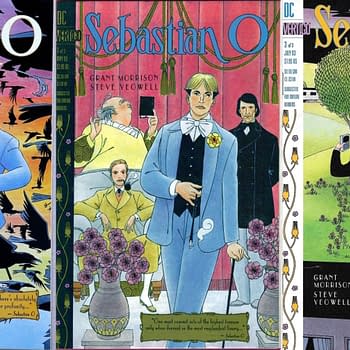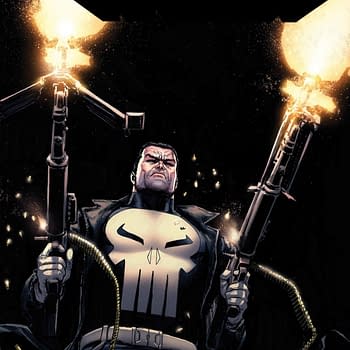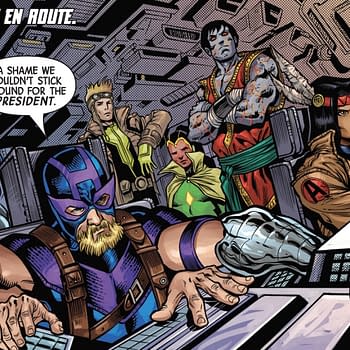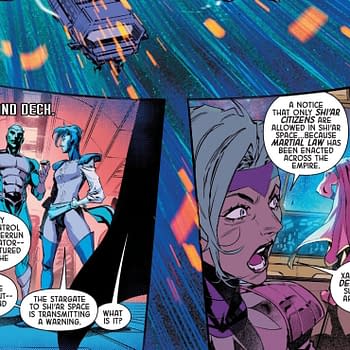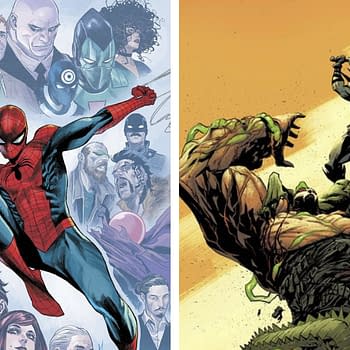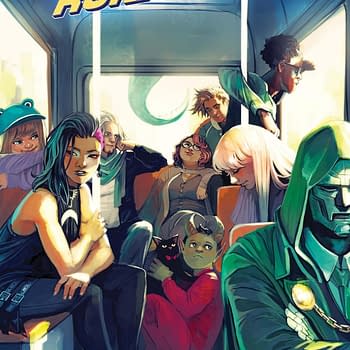Posted in: Comics, Recent Updates | Tagged: battleworld, Comics, Convergence #7, entertainment, image comics, Injection, insufferable, Marvel Comics, Secret Wars, Swords of Sorrow
Thor's Comic Review Column – Convergence Week 7, Insufferable #1, Sword Of Sorrow #1, Injection #1, A-Force #1, Ultimate End #1, Battleworld: Master of Kung Fu #1 And Secret Wars #1
This Week's Reviews:
Convergence #7
Convergence: The New Teen Titans #2
Convergence: Flash #2
Insufferable #1
Swords of Sorrow #1
Injection #1
A-Force #1
Ultimate End #1
Battleworld: Master of Kung Fu #1
Battleworld: Secret Wars #1
Convergence Week 7
By Graig Kent
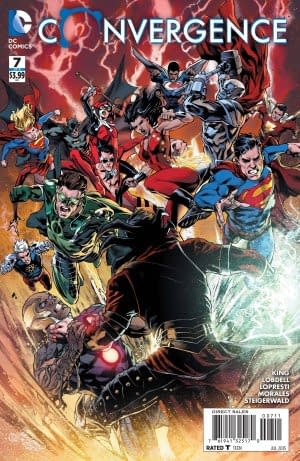
Well, true to form, there was the requisite punching-out in Convergence #7 (DC, $3.99), a rather drab "good heroes" versus "bad heroes" throwing down in the vast desert terrain on Telos. Artist Aaron Lopresti, with inker Mark Morales and colorist Peter Steigerwald, delivers some exceptionally clean and vibrant figures here, but the setting leaves much to be desired (as it has from the onset). Desert duke-outs are so very dull. The fighting unfortunately feels so staged and unnatural that it's difficult to invest in, and it's so toothless that it's hard to believe that there are any stakes at all. The two-page spread that kicks off the battle royale borders on parody of what these kind of battles are supposed to look like, with random one-on-one conflicts that seem illustrated with tongue firmly in cheek. The pages that follow don't really give Lopresti anything to focus on, visually, and the series of random images of fights give no sense of danger for any character.
Telos (the planet's avatar) joins the fray and takes on Deimos in a battle that can at best be described as nonsense. There are continued questions about Telos' power set, and likewise Deimos' magic+power over time seems ill defined, such that when the two of them are pitted against one another, and there's no concept of what could or should happen in this contest. It doesn't really seem like writer Jeff King or artist Lopresti really know what to do with it either.
In the throes of battle the "good heroes" and the "bad heroes" learn of Deimos' ultimate, nihilistic goal, and band together in a cheesy about-face, while the sudden interloping of a previous event's Big Bad does change the game once more, but in an almost farcical way.
Like last issue, there are distinct pages that interject events occurring in the New 52 DCU (I presume these are written by Scott Lobdell as he suddenly appeared with a writer credit last issue). Last issue seemed to tease the modern DCU's incoming involvement in the events on Telos (and I fully expected to see New 52 characters joining the battle on the planet and helping sort things out), but this issue keeps them completely separate, with no obvious connection between the Telos/Deimos fight and what the Justice League and this "Great Oracle" character are encountering.
King and company have one issue to bring it all home to a satisfying conclusion, but it hasn't really been all that satisfying up to this point anyway so I won't hold my breath. I went into Convergence with little expectations, so I can't say I'm terribly disappointed with it, but I'm wholly underwhelmed. Like with Daniel H. Wilson on Earth 2: World's End, putting a major series into the hands of a rather unproven and untested comic book writer (despite whatever other fields they have had success in) has shown that it doesn't pay off with a satisfying final product. There's no shortage of underutilized, experience comic book writing talent that could have taken on this series, surely guys like King and Wilson could cut their teeth on tie-in books or smaller series first before being handed epics and events where they muddle through learning how to write for the format.
—
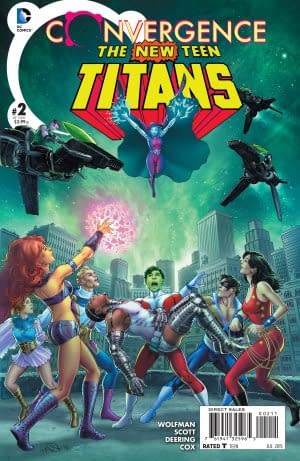
With Convergence: The New Teen Titans #2 (DC, $3.99) all the great foundation that Marv Wolfman laid in the first issue was seemingly tossed out the window. The final panel of last issue implied that the heroes were going to work together to bust out of what was expected of them, that they weren't going to simply fight each other, but instead fight for what's right.
Alas.
The truce lasts for two pages before everything falls apart. The Tangent Universe Doom Patrol attacks the Titans and kidnaps a weakened Cyborg so that they can steal his power cell which they suspect they can use to power a device and get back to their Earth. It's all fights and bickering, and melodrama of the most awkward sort (was that Jericho coming out to Kole…? Or perhaps, Kole, he's just not that into you?) leading to nothing. Nothing really at all. Like the past two weeks, the tie-ins all end with the heroes experiencing a tremor (of various levels of severity, depending on the book) and some form of wishful thinking about a future.
The back-up here is an 8-page promotion for Robin: Son of Batman from writer/artist Patrick Gleason. To be honest, I didn't even read it. Gleason's art (with inks from Mick Gray) looks as fantastic as ever, but even with all the eye-popping visuals, I can't even be bothered. I last saw Damian Wayne in a grave and even though I grew to like the character before that, I'm more than okay with keeping him there.
—
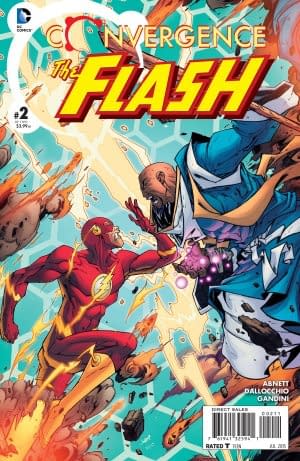
Convergence: Flash #2 opens with Barry Allen face-to-face with the Tangent Universe's Superman. I've only a miniscule amount of exposure to the Tangent Universe in the past, and never met its Superman before, but in writer Dan Abnett's hands he's a freaking impressive character. His brain is constantly evolving at an accelerated rate so he's hyper-intelligent, and Abnett does a wonderful job of showing it, without making him a cold and completely detached individual (the moment he shares with Barry about classic Star Trek is a wonderful touchpoint for his humanity). The first 8 pages of the book are all talk, and it's tremendous with Abnett exploring both characters personalities, their abilities, and their thoughts on their situation. More than most tie-in writers, Abnett seems interested in truly exploring what is happening and why (frankly, I'm thinking Abnett should have been in charge of the overall event based on this)..
Poised atop a Metropolis skyscraper, artist Federico Dallocchio covers the scene from all angles. Dallocchio's draughtsmanship creates a believable cityscape that has been detached from its natural home, plunked on a foreign planet, with another city visible off in the distance. Of all the Convergence books, this is the best realization of the reality of Telos, and with deceptively simplistic ease.
Barry talks himself out of an alliance with Tangent Superman (in some ways Abnett's Flash reflects more of the modern TV show Barry Allen than vintage comic book Barry) and the fight that ensues (particularly after the 8 pages of set-up) plays out beautifully. Both the resolution to the fight, and the story, are particularly well done, with Abnett injecting both DCU history and logic into how things play out, while Dallocchio just captures every moment with a note-perfect widescreen flourish. DC should be seriously considering a "Tangent Superman" book from these two, that's just how good it is (and I would definitely read that).
The back-up feature in this issue delivers 8 pages of Suicide Squad from Sean Ryan and Philippe Briones. Bookends take place in some sort of office or government building, with a pair of suits discuss the status of Task Force X. Meanwhile in the Ukraine, Harley Quinn, Black Manta and Captain Boomerang take on a mecha Rocket Red with Amanda Waller on comms. Ostensibly there's nothing wrong with this. It's pithy, fun, and well-illustrated, but something rings false about it. I just don't buy this trio as a team and I still don't get the rationale for putting a wild card like Harley in on special ops missions (beyond the publisher taking advantage of the character's popularity).
—
Next week, it's over. Plus, "Convergence Best and Worsts"
Graig Kent has tallied up how much money he's spent on Convergence books and he's not happy about it. He can be found not tweeting on twitter @thee_geekent or not writing other places on the interwebs. He also just watched The Jinx, and holy $#@!.
Insufferable #1 (IDW, $3.99)
By Cat Taylor
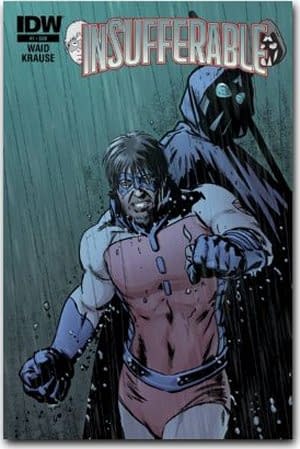
While the Insufferable series orginally ran as a digital comic in 2012, and was collected and published through Waid's own Thrillbent Comics, it now being published again in single issue print copies by IDW. Many of the more hip readers have probably already read the whole series but I imagine that there are a lot of people like myself who are just now discovering this series through the better marketing and wider distribution available through IDW. As far as I'm concerned, that's good news because there aren't many superhero comics that can take the flawed hero concept and make it something worth reading these days, but Waid is the kind of writer who knows what makes a story like that fly. With Insufferable, he uses two thinly veiled Batman and Robin archetypes and tells the tale of what happened after they had a parting of ways and the former sidekick struck out on his own to achieve fame and success.
There are two big differences between what DC did with Robin becoming Nightwing, and the story Waid tells of former sidekick, Galahad. The first is that in Waid's story, the Batman archetype, Nocturnas, is now in his early fifties and no longer at his peak level of performance. The second, and more important difference, is that Galahad is an arrogant douchebag who turns his crimefighting career into celebrity stardom for himself and also uses every opportunity he can to verbally discredit Nocturnas. A couple of the more distasteful elements of modern society that are shown through Galahad's arrogance are the unearned entitlement attitude of celebutantes and the anonymous trolling that internet message boards have created (not that anyone who posts comments on Bleeding Cool is guilty of that, of course!).
When I view Galahad as a kid who grew up being adored by the public in general and receiving his only criticism from his mentor, Nocturnas. I can kind of see how such an arrogant entitlement attitude would develop. After all, the Hiltons, Kardashians (with whom I can't keep up), and Lohans of the world certainly come off as arrogant and whiny as Galahad, and they aren't even saving lives and preventing crimes! In addition, someone as young as Galahad would have grown up with the internet and would see no problem with expressing his opinions through online comments columns as belligerently as possible and with no thought of social grace and decorum.
While the entire story has yet to be told, the first issue provides a few reasons why Galahad resents Nocturnas enough to publicly bury him whenever possible. In my opinion, the reasons we're shown so far aren't nearly enough to justify his behavior but that's probably the point. In the synopsis of the book, Waid said that one character flaw he can't stand in people is arrogance, and Galahad is Waid's expression of his distaste for that personality trait. It could be that Waid hates arrogance so badly that he's resorted to making Galahad one-dimensional, but I suspect we're going to see that there's more to Galahad than has been revealed so far.
Although Waid has explored some ugly personalities in comics before, Insufferable is different enough to be worthwhile. For instance, unlike the main character in Irredeemable, Galahad may be a jerk but he's not an all-powerful jerk, and he's still fighting for justice, law, and order. However, if you liked Irredeemable, then you'll be happy to know that Waid is working with the same creative team on this series, namely artist Peter Krause, colorist Nolan Woodward, and letterer Troy Petrie. The result is a comic, like Irredeemable, that has the look and feel of the more sophisticated superhero books but with characters and subjects that you won't find in most mainstream comics. As far as I'm concerned, a Waid comic is always going to be worthwhile. So, I'd have a hard time not recommending this series. However, each person has their own tastes and I assume that if you love comics enough to read this column then you already have an opinion of Waid's work. Therefore, take my recommendation with a grain of salt but know that this series is out there and it's calling you.
Cat Taylor has been reading comics since the 1970s. Some of his favorite writers are Alan Moore, Neil Gaiman, Peter Bagge, and Kurt Busiek. Prior to writing about comics, Taylor performed in punk rock bands and on the outlaw professional wrestling circuit. During that time he also wrote for music and pro wrestling fanzines. You've got a little something on your face there. Do you need a tissue? You can e-mail Cat at cizattaylor@hotmail.com.
Debut Double Bill: Swords of Sorrow #1 & Injection#1
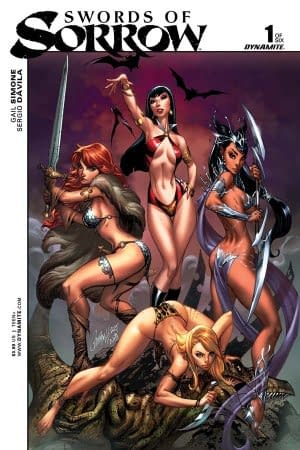
Last time I reviewed a comic by Gail Simone, I spent a considerable amount of time and words agonising over the fact that I felt like a hypocrite for liking her work in principle whilst never having knowingly read an issue of her work cover to cover before. Well, fret not – as of this review I have now read two issues. Glory fucking Hallelujah.
When Swords of Sorrow was first announced, in what was then an untitled crossover that would unite Dynamite's Red Sonja, Vampirella and Deja Thoris of Mars, I decided that there simply was no way I would pass up the opportunity. All this time later, it turns out that the book is playing host to pretty much every female character Dynamite Publishing currently has the license to: Jennifer Blood, Jungle Girl and the female Kato* make principle appearances, with cameos by the likes of Irene Adler and Ladies Zorro and Greystoke**, each being recruited from across time and space by a Courier for a mysterious female warrior who is seeking generals for… some reason. Apparently there's some conflict between her and an unnamed dark prince who has summoned a cabal of even sluttier looking women warriors to be his henchmen – if they're meant to be people I should know, I don't recognise any of them.
A cynical person might assume that this miniseries is being sold mostly on sex appeal, and the cover art by J.Scott Campbell doesn't exactly provide a convincing counter-argument. By contrast, the interior art by Sergio Dávala, whilst not exactly realistic, is more subdued and focuses more on musculature and action poses rather than cheesecake cleavage shots. Then there's Dark Prince's Petticoat Army (*shudder*) . Simone's work as usual speaks for itself – she manages to infuse each of the characters with a little personality and quirks, like the fact that Red Sonja is a total booze-hound.
The story proper is a little flimsy at this point, and just as Elric: The Balance Lost… ahem, lost me after one volume and the novelty of a Michael Moorcock-themed comic multiverse wore off, I'm not sure if I can muster enough interest in the story here to follow it through to the end. That said, Swords of Sorrow's primary series is only six issues long and if ignoring the numerous offshoots doesn't completely break the flow, I can stand to see more of this series and hopefully figure out who everyone is and why I should care.
Meanwhile, in Image County…
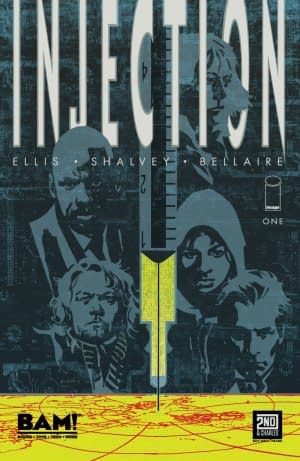
Maria Kilbride is in a mental asylum. A former member of the Cultural Cross-Contamination Unit, she is called out of her enforced retirement to take a job from one of her former employers. Likewise, her former colleagues Robin Morel and Brigid Roth are approached. Also, there's an IT Crowd joke that's in incredibly dubious taste.
It's a bit of a mystery wrapped in an enigma tied up with a bow made of headfuckery at this point, but there's definitely some intrigue afoot. Between these two books I'm probably not even going to miss whatever's going on at DC at the moment. And frankly, I couldn't be happier about that.
Adam X. Smith can't believe people have a problem with Mad Max: Fury Road's sexual politics – if they're willing to accept that Tom Hardy and Mel Gibson are meant to be the same person, why can't they respect women?
*I grew up with the Bruce Lee version, but I'm gratified to learn that this version's first name is Mulan.
**Jane Porter, I presume.
And So We Enter Battleworld.
By Jeb D.
A-Force #1 (Marvel, $4.99)
Ultimate End #1 (Marvel, $4.99)
Battleworld: Master of Kung Fu #1 (Marvel, $4.99)
Battleworld: Secret Wars #1 (Marvel, $4.99)

She begins by glossing over the still-relevant fact that the book is written by two women. It's unfortunate that we have to view the credits of a female-focused book as a kind of scorecard, but given the inevitability of it, let's chalk up two big wins for A-Force, having been co-written by Ms Marvel's G. Willow Wilson and Angela: Asgard Assassin's Marguerite Bennett; art is from X-chromosome owners Jorge Molina and Craig Yeung, and color by the Nick-and-Nora pairing of Matt Milla and Laura Martin. This is the first of the flood of minis spilling out from Secret Wars, and our introduction to a social structure outside the immediate shadow of God-King Victor Von Doom.
Lepore's allegations that the story is difficult to comprehend for newbies is a puzzling one: the only way anyone could possibly be confounded by the storyline in this issue would be to come to it with preconceived expectations of the characters involved; I could understand a long-time reader wondering why it happens that She-Hulk is in charge, as opposed to, say, Captain Marvel or Medusa (who's actually a queen), but taken as a new beginning, there's just enough expository dialogue to allow the new reader to climb onboard, and enough context to help them along. Doom's world is no more or less alien than Westeros or Middle Earth, and it really takes no great leap to engage with it: a team of female heroes avert a crisis, and in the process introduce us to their world, their personalities, and their relationships.
Lepore's larger point has (unsurprisingly) to do with gender issues. This one is, perhaps, a little more understandable, given that many such issues impact our culture across the board, but her complaining about the glamorization of these women rings pretty false when you compare their matter-of-fact visual depictions here with those all-too-common comics that can't depict women without resorting to gratuitous boob and butt shots, or which can't elevate their thinking past tired damsel in distress tropes. Are these characters attractive and stylish? Yes. Can women be portrayed as attractive and stylish, equally appealing to female readers as well as male, without being presented in an exploitative manner? Again yes.
Corporate superhero comics have long borne as much resemblance to the TV soap opera as any other genre: both feature storylines that treat the absurd as mundane, they rely on the audience's familiarity with a core group of characters repeating their encounters with each other again and again, and character development is barely incremental over the course of decades. And, like soap operas, superhero comics tend to feature impossibly glamorous men and women. Are there gender issues at the heart of our concepts of glamor? Sure—see the recent flap over the mandated wearing of high heels for women on the Cannes red carpet. But to suggest that there is no discernable difference between the extremes of the male gaze that have characterized too many superhero comics over the years, and what is being presented here—pretty, capable women flying around in flashy costumes—seems almost willfully ignorant.
Actually, Wonder Woman's history is somewhat evoked by this first issue, which is redolent of the Amazon Princess' Silver Age adventures, by employing an uber-Megalodon as its source of danger. Rampaging giant creatures were very much de riguer for Wonder Woman in the years between Kanigher and, say, Perez. Stories with human foes, whose objectives are frequently tied to questions of dominance and submission, can be queasy concepts for some writers where female heroes are involved, and I suspect that DC editorial felt more comfortable every time Diana faced down some goofy Kirbyesque behemoth, or giant egg, instead of a mustache-twirling bad guy who could be presumed to have the nasty on his mind. In fact, this issue's giant-shark battle is just the loosest of frameworks on which to hang an engaging series of encounters among the various well-characterized female heroes (including [Ms] America, Storm, and Spider-Woman in her old costume), bringing us up to speed on their corner of the Battleworld. We're not on Themyscira by any means, though: Medusa appears to still be married to Black Bolt (though she's wearing her old Frightful Four costume), and Namor is among the forces at She-Hulk's command. It's mostly (entertaining, character-driven) place-setting until we get to the last-page development that will push the series forward. The art from Molina and Young is appealing, clean, comfortable old-school superhero: it appears that any breaking of new ground will be left strictly to the script.
As distinct from many of the off-the-wall concepts that make up the Secret Wars/Battleworld event, A-Force seems clearly tailored for ongoing life in a newly-reconstituted Marvel Universe… which is all well and good, but rather mitigates the fun of such miniseries. What made predecessors like 1602 or Marvel Noir entertaining was placing favorite characters into new environments that involved either extending their customary characteristics to fit the alternate-world setting, or inverting our expectations (bad guys turn good, etc.). The female heroes here are members of the A-Force because… well, mostly because they are. Save the sanitizing of Sister Grimm (either she no longer needs to bleed to produce her staff, or they're hoping we've forgotten that aspect), everyone here is a familiar character, behaving pretty much as we expect her to. And apart from a couple of allusions to Doom as the ultimate source of governmental power, there's not much to suggest that these women are operating in a world where medieval castles and post-apocalyptic landscapes exist just past their borders; only the tiniest of tweaks would have been needed to set this series in the regular 616. Fans who want to get in on the ground floor of what will likely be an important team book in Marvel's future should certainly enjoy the sharp dialog and comfortably old-school artwork on display here, and if you're all in on Secret Wars/Battleworld, this might be one of the better series. But if you're looking forward to the kind of craziness promised by such upcoming Battleworld titles as M.O.D.O.K. Assassin, Weirdworld or Mrs. Deadpool and the Howling Commandos, and you're on a budget, you might want to spend your coin on those and pick up the A-Force when it resurfaces as the ongoing mainstay I expect it to be for a while.
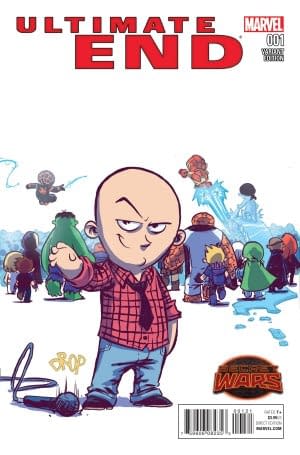
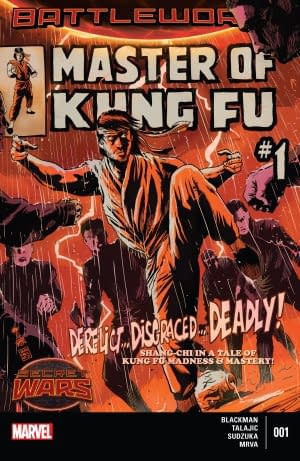
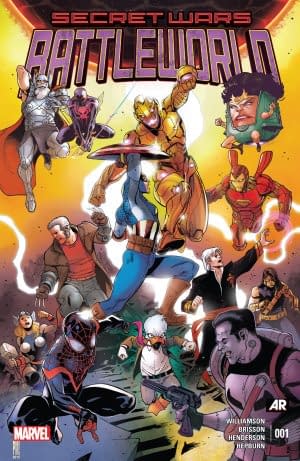
*It's unfortunate that Lepore's fascinating book, which devotes much attention to the kinky living arrangements of WW creator William Moulton, rather overshadowed "Wonder Woman Unbound," released the same year, by Tim Hanley, who's clearly much more at home with the history and tropes of comics. He's also a near-parody of a stats geek: calculating percentages of bondage panels over the course of the series, and such; among other things, his book informs us that the use of the phrase "Suffering Sappho" went from 0.5 incidents per issue to 1.4 per issue during Robert Kanigher's tenure on the character).
Jeb D. saw Mad Max: Fury Road in D-Box. It was free. But he'd have paid for it.










